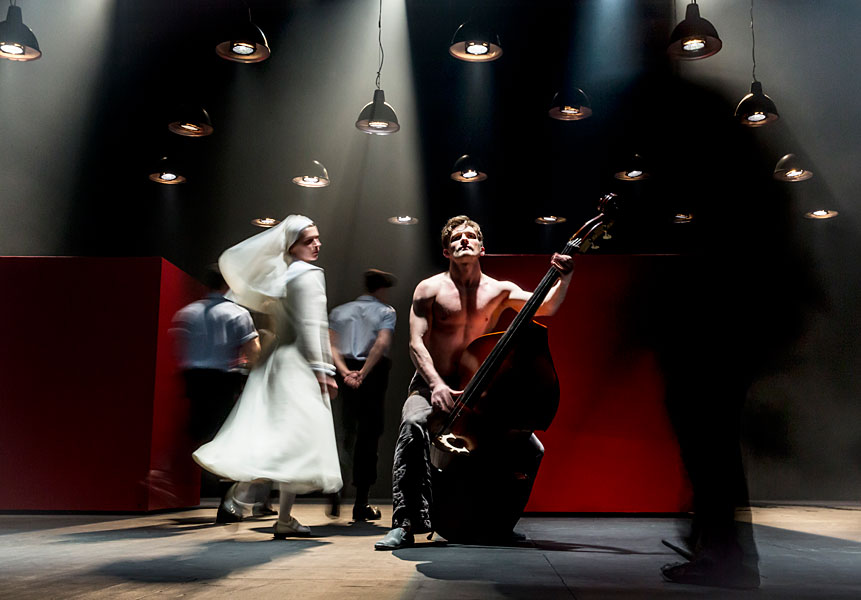
April 22, 2015, by Peter Kirwan
Measure for Measure (Cheek by Jowl) @ The Barbican – live stream
I have already written two reviews of Cheek by Jowl’s Measure for Measure (here and here), but tonight I had an opportunity to see it again, this time in the company’s first ever live broadcast.
Firstly, it’s an extraordinary offering. A prestigious production being broadcast internationally for free online is a bold statement, and canny. This screening will no doubt have introduced a huge new audience to Cheek by Jowl’s Russian work, even if only insofar as this particular production is only playing in London and Oxford in the UK. It also gives the Russian work a prominence that it richly deserves within the company’s own repertoire, making a statement about the company’s multinational identity.
The screening brought out a great deal. The chance to see Andrei Kuzichev, in particular, close up during Angelo’s self-admissions of his lust for Isabella, was very welcome, bringing out the facial tics and sighs that characterised his restrained performance. The framing of moments such as Pompey’s threatening of the prostitute emphasised the threat and added an almost filmic quality at times, while the frequency of over-the-shoulder perspective shots heightened the atmosphere of surveillance that pervaded the production.
On a third viewing, and notwithstanding my own bias given I’m about to start working intensively on the company’s work, this production only becomes more revelatory. When I saw it at the Barbican I was struck by the dance-like quality of the whole, the fluid movement between locations, between actions, between emotional states. Up close, this time I was stuck by the terror and pain of individuals, particularly of the Duke as he clutched repeatedly at his head, or Claudio fell crouching to the floor, thrashing his sister away from hi in terror at the prospect of death. This is what makes Cheek by Jowl so fascinating to work on – some companies concentrate only on the physical business, others on naturalistic characterisation, but no company in my opinion handles so intelligently the oscillation between the individual experience and the spatial patterning, and wrings so much from both simultaneously.
There were inevitable compromises. Both the sound quality and the effect of the lighting suffered in the broadcast. The sound was less of an issue, the voices simply sounding more distant than they perhaps should, but the muting of the subtle lighting design was disappointing – the contrast, for example, between the top-down, cold lighting of the opening court scene and the harsh, side-on glare which caught the brothels in the headlights was diminished.
Perhaps more importantly, the broadcast reinforced to me the importance of being able to see the entire of a Cheek by Jowl production at the same time. With actors performing across such a vast space, and a constant onstage presence by most of the company, the close-ups on individual actors mean that much of the overall sense of blocking and design was lost. One crucial example was that many of the instances of Barnardine holding the Duke in comfort at the back or sides of the stage while other scenes took place were not visible. Much of the unique effect of Cheek by Jowl’s work is generated by the space between bodies; but this requires those bodies to be seen.
But this is to point out the understandable qualitative difference between a free online screening and presence at a live event, and it is remarkable that the cameras managed to capture dynamically so much of the back and forth among the company, the contours of the stage as the cast circled round the edges of the stage, and the interplay between the silent presences. This production, with its wide stage and its large expanses of empty space between actors, places particular demands on a camera crew, and the broadcast wisely chose to make frequent recourse to the most distant camera, keeping constantly in the viewer’s mind the entirety of the blocking. More importantly, the more graphic elements had an undeniable impact in close-up, particularly Angelo’s assault on Isabella.
Finally, in close-up, the quietness had extraordinary effect. I was struck, this time, by the contrast between Isabella and Claudio’s two meetings. The first, extraordinarily violent and charged, building from sobs and comfort to screams to the beginnings of a sexual assault. The second, Isabella standing, desolate, just outside Claudio’s family unit as he refuses her. Similarly, Barnardine’s first setpiece, exposing the Duke to the horrors of his underworld, contrasted beautifully with the Duke’s gentle shushing of him as he lay, sprawled and screaming in fear of violence, on the floor when brought forward for his final release. Moments such as this benefit enormously from the close-up enabled by cameras, and future events of this kind will go a great way towards opening up fresh aspects of Cheek by Jowl’s work.
No comments yet, fill out a comment to be the first

Leave a Reply